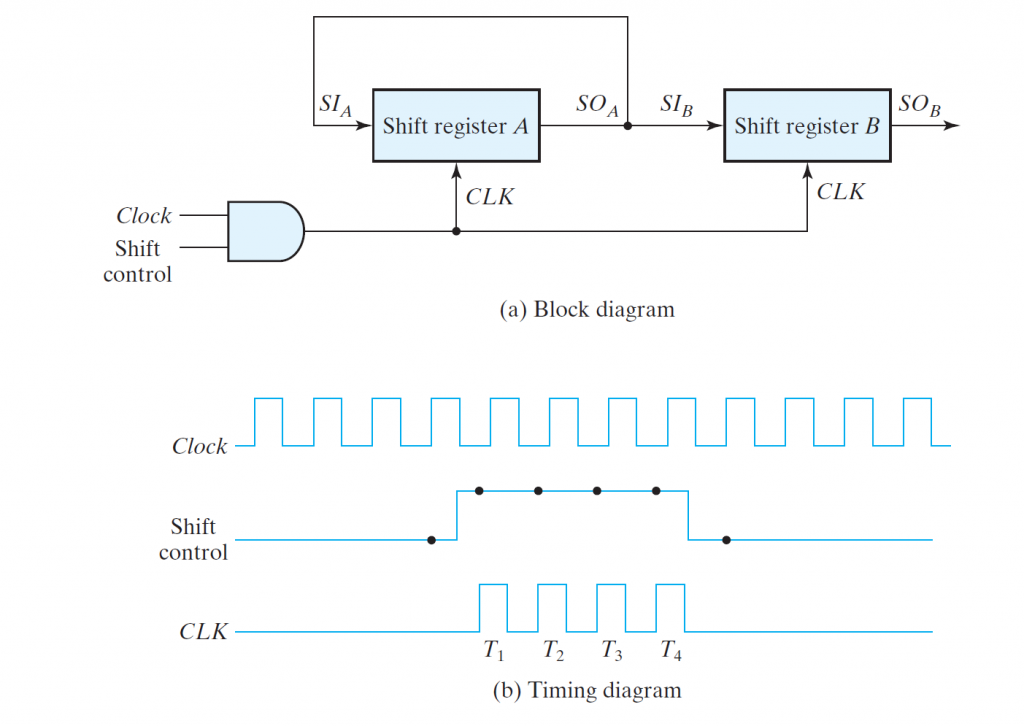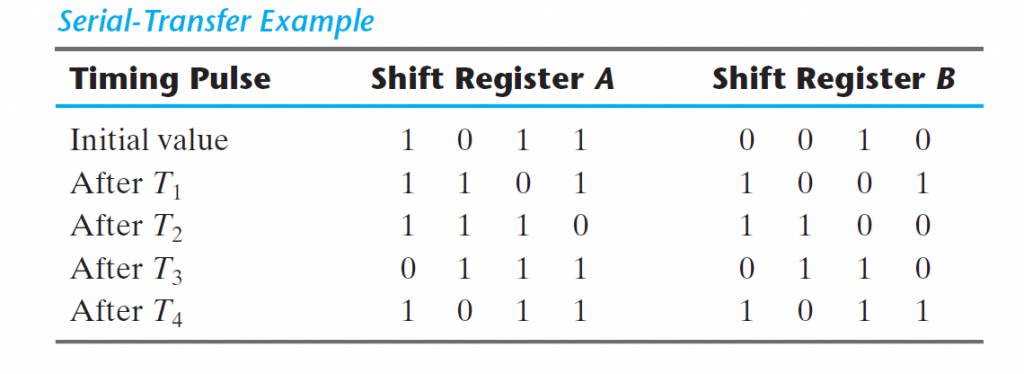what are the Serial Transfer and Serial Shift Properties of Shift Registers?
what are the serial transfer and serial shift properties of shift registers? Serial Transfer is defined as “Transmission of information as sequential units. For example, if two computers connected by a single wire wish to communicate an 8-bit unit “.Serial transmission is a form of signal transmission that sends information one bit at a time over a signal data channel.
Serial interfaces are generally used to connect data communications equipment(DCE) such as modems to data terminal equipment (DTE) such as computers and terminals and for connecting a (DCE) to a (DTE).
Serial communication is a communication technique used in telecommunication wherein data transfer occurs by transmitting data 1 bit at a time in a sequential order over a computer bus or a communication channel. It is the simplest form of communication between a sender and a receive.
When data is sent or received using serial data transmission, the data bits are organized in a specific order, since they can only be sent one after another. The order of the data bits is important as it dictates how the transmission is organized when it is received.

Serial transfer usages:
Serial transmission is normally used for long-distance data transfer. It is also used in cases where the amount of data being sent is relatively small. Serial communication is used for all long-haul communication and most computer networks, where the cost of cable and synchronization difficulties make parallel
Function of serial transfer
The main advantage of serial communication is, the cost of the entire embedded system becomes cheap and transmits the information over a long distance. Serial transfer is used in DCE (Data communication Equipment) devices like a modem. In parallel communication, a chunk of data (8,16 or 32 bit) is sent at a time.
Example:
. One example of serial mode transmission is a connection established between a computer and a modem using the RS-232 protocol. An RS-232 cable can accommodate 25 wires, but only two of these wires are for data transmission; the rest are designated for overhead control signaling.


Shift Registers in Digital Electronics
What is serial shift?
In this shift register, we can send the bits serially from the input of left most D flip-flop. Hence, this input is also called as serial input This is useful as many circuits work on groups of bits in parallel, but serial interfaces are simpler to construct. The shift registers are used for temporary data storage. The shift registers are also used for data transfer and data manipulation. The serial-in serial-out and parallel-in parallel-out shift registers are used to produce time delay to digital circuits.
Serial shift usages
Shift Shift are used for data storage or for the movement of data and are therefore commonly used inside calculators or computers to store data.
Function of Serial Shift
Serial-in, serial-out shift registers delay data by one clock time for each stage. They will store a bit of data for each register. A serial-in, serial-out shift register may be one to 64 bits in length, longer if registers or packages are cascade.
Example;
The shift registers are used for temporary data storage. The shift registers are also used for data transfer and data manipulation. The serial-in serial-out and parallel-in parallel-out shift registers are used to produce time delay to digital circuits.
Property of Shift register:
A shift register is a device that inputs data loaded serially into a basic.
Which shift register has the property of entering the bits simultaneously into respective stages on parallel lines with parallel data input inspite of .
With the shift register, data or bits are entered into the system in a serial or parallel manner. They enter from one direction, and as more data is added.
Explanation
A shift register is a type of digital circuit using a cascade of flip flops where the output of one flip-flop is connected to the input of the next. Shift Registers are basically a type of sequential logic circuit used to “store” and “shift”/ “transfer” data bits either in serial or parallel or a combination.
In terms of features, some shift registers are radiation tolerant or provide protection from electrostatic discharge (ESD). With the shift register, data or bits are entered into the system in a serial or parallel manner. They enter from one direction, and as more data is added.
Electronics Tutorial about the Shift Register used for Storing Data Bits including the Universal Shift Register and the Serial and Parallel Shift Register.
Shift Registers are sequential logic circuits, capable of storage and transfer of data. They are made up of Flip Flops which are connected in such a way that the output of one flip flop could serve as the input of the other flip-flop, depending on the type of shift registers being created.
Function of Shift register
Shift Registers are used for data storage or for the movement of data and are therefore commonly used inside calculators or computers to store data such as two binary numbers before they are added together, or to convert the data from either a serial to parallel or parallel to serial format.
The serial-in parallel-out shift register is used to convert serial data into parallel data thus they are used in communication lines where demultiplexing of a data line into several parallel line is required.
Which shift register is fastest?
Shift registers can have both parallel and serial inputs and outputs. … A PIPO register (parallel in, parallel out) is very fast – an output is given within a single clock pulse.
Types of Shift Registers
- Serial in Serial out (SISO) Shift Register.
- Serial in parallel out (SIPO) Shift Register.
- Parallel in Serial out (PISO) Shift Register.
- Parallel in Parallel out (PIPO) Shift Register.
Modes of Operation of Shift Registers
- Serial In – Serial Out (SISO) Mode.
- Serial In – Parallel Out (SIPO) Mode.
- Parallel In – Serial Out (PISO) Mode.
- Parallel In – Parallel Out (PIPO) Mode.
Also read here
What is a parity bit? How to design a Parity bit checker and generator?